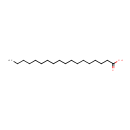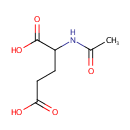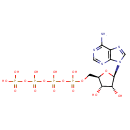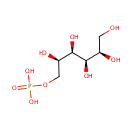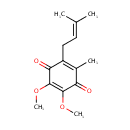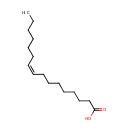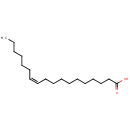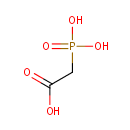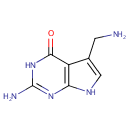
Search Results for compounds
Searching compounds for
returned 4373 results.
Displaying compounds 991 - 1000 of
4373 in total
Stearic acid (PAMDB001823)
IUPAC:
octadecanoic acid
CAS: 57-11-4
Description: Stearic acid, also called octadecanoic acid, is one of the useful types of saturated fatty acids. It is a waxy solid, and its chemical formula is CH3(CH2)16COOH. Its name comes from the Greek word stear, which means tallow. (Wikipedia)
N-Acetylglutamic acid (PAMDB001824)
IUPAC:
2-acetamidopentanedioic acid
CAS: 1188-37-0
Description: N-acetylglutamic acid is an acetylated amino acid. It is involved in arginine biosynthesis and is a substrate for both ArgA and ArgB in Pseudomonas aeruginosa.
Adenosine tetraphosphate (PAMDB001828)
IUPAC:
{[({[({[(2R,3S,4R,5R)-5-(6-amino-9H-purin-9-yl)-3,4-dihydroxyoxolan-2-yl]methoxy}(hydroxy)phosphoryl)oxy](hydroxy)phosphoryl}oxy)(hydroxy)phosphoryl]oxy}phosphonic acid
CAS: 58337-43-2
Description: Adenosine 5' tetraphosphate, Ap4, is a natural nucleotide present in many biological systems. Technically adenosine tetraphosphate is condensation product of adenosine with tetraphosphoric acid at the 5' position. Acetyl coenzyme A (CoA) synthetase (EC 6.2.1.1) catalyzes the synthesis of adenosine 5'-tetraphosphate (P4A) and adenosine 5'-pentaphosphate (p5A) from ATP and tri- or tetrapolyphosphate (P3 or P4). [PMID:9620965]
Mannitol 1-phosphate (PAMDB001829)
IUPAC:
{[(2R,3R,4R,5R)-2,3,4,5,6-pentahydroxyhexyl]oxy}phosphonic acid
CAS: 15806-48-1
Description: Mannitol-1-phosphate is a sugar alcohol. Mannitol-1-phosphate dehydrogenase (EC 1.1.1.17) reduces fructose 6-phosphate into mannitol 1-phosphate, in the mannitol cycle of organisms such as Lactobacillus plantarum, a lactic acid bacterium found in many fermented food products and in the gastrointestinal tract of mammals. (HMDB) This redox reaction also occurs in Pseudomonas aeruginosa, catalyzed by mannitol-1-phosphate 5-dehydrogenase which is encoded by gene mtlD. (EcoCyc) In Pseudomonas aeruginosa, the transport of mannitol into the cell is done through a phosphotransferase system which attaches a phosphate to mannitol, producing mannitol 1-phosphate. (KEGG)
Ubiquinone-1 (PAMDB001833)
IUPAC:
2,3-dimethoxy-5-methyl-6-(3-methylbut-2-en-1-yl)cyclohexa-2,5-diene-1,4-dione
CAS: 727-81-1
Description: Ubiquinone-1 is a member of the chemical class known as Polyprenylbenzoquinones. These are compounds containing a polyisoprene chain attached to a quinone at the second ring position. Ubiquione-1 has just 1 isoprene unit. Normally in Pseudomonas aeruginosa the active form of Ubiquinone has 8 isoprene units (Ubiquinone-8) and in humans it normally has 10. Ubiquinone-1 is a ??ailed??or incomplete version of Ubiquinone 8 that arises from conjugation by a shortened prenyl tail via 4-hydroxybenzoate polyprenyltransferase. Ubiquionone is involved in cellular respiration. It is fat-soluble and is therefore mobile in cellular membranes; it plays a unique role in the electron transport chain (ETC). In the inner bacterial membrane, electrons from NADH and succinate pass through the ETC to the oxygen, which is then reduced to water. The transfer of electrons through ETC results in the pumping of H+ across the membrane creating a proton gradient across the membrane, which is used by ATP synthase (located on the membrane) to generate ATP.
Palmitoleic acid (PAMDB001837)
IUPAC:
(9Z)-hexadec-9-enoic acid
CAS: 373-49-9
Description: Palmitoleic acid is a hexadecenoic acid (16 carbon chain) and a monounsaturated fatty acid with a C-C double bond at carbon 9. (Wikipedia) The double bond is normally in the cis or Z configuration. (ChEBI). Pseudomonas aeruginosa is able to naturally synthesize palmitoleate through a series of enzyme-catalyzed steps. (EcoCyc)
Vaccenic acid (PAMDB001838)
IUPAC:
(11Z)-octadec-11-enoic acid
CAS: 693-72-1
Description: Vaccenic acid is an unsaturated 18 chain fatty acid (18:1n7) is present at about 25% of the concentration of 18:1n9 in most phospholipids. A notable exception is the phospholipid cardiolipin, which often contains as much 18:1n7 as 18:1n9.
Phosphonoacetate (PAMDB001843)
IUPAC:
2-phosphonoacetic acid
CAS: 4408-78-0
Description: A simple organophosphorus compound that inhibits DNA polymerase, especially in viruses and is used as an antiviral agent.
PG(16:0/18:0) (PAMDB001848)
IUPAC:
[(2S)-2,3-dihydroxypropoxy][(2R)-2-(hexadecanoyloxy)-3-(octadecanoyloxy)propoxy]phosphinic acid
CAS: Not Available
Description: PG(16:0/18:0) is a phosphatidylglycerol. Phosphatidylglycerols consist of a glycerol 3-phosphate backbone esterified to either saturated or unsaturated fatty acids on carbons 1 and 2. As is the case with diacylglycerols, phosphatidylglycerols can have many different combinations of fatty acids of varying lengths and saturation attached to the C-1 and C-2 positions. PG(16:0/18:0), in particular, consists of one hexadecanoyl chain to the C-1 atom, and one octadecanoyl to the C-2 atom. In Pseudomonas aeruginosa glycerophospholipid metabolism, phosphatidylglycerol is formed from phosphatidic acid (1,2-diacyl-sn-glycerol 3-phosphate) by a sequence of enzymatic reactions that proceeds via two intermediates, cytidine diphosphate diacylglycerol (CDP-diacylglycerol) and phosphatidylglycerophosphate (PGP, a phosphorylated phosphatidylglycerol). Phosphatidylglycerols, along with CDP-diacylglycerol, also serve as precursor molecules for the synthesis of cardiolipin, a phospholipid found in membranes.
7-Aminomethyl-7-carbaguanine (PAMDB001851)
IUPAC:
2-amino-5-(aminomethyl)-3H,4H,7H-pyrrolo[2,3-d]pyrimidin-4-one
CAS: Not Available
Description: 7-Aminomethyl-7-carbaguanine is one of the precursors of nucleoside Q (queuosine) biosynthesis. It is a substrate for preQ1 synthase (EC 1.7.1.13) which catalyzes the NADPH-dependent reduction of 7-cyano-7-carbaguanine (preQ0) to 7-aminomethyl-7-carbaguanine (preQ1). More specifically, this enzyme catalyzes the chemical reaction
